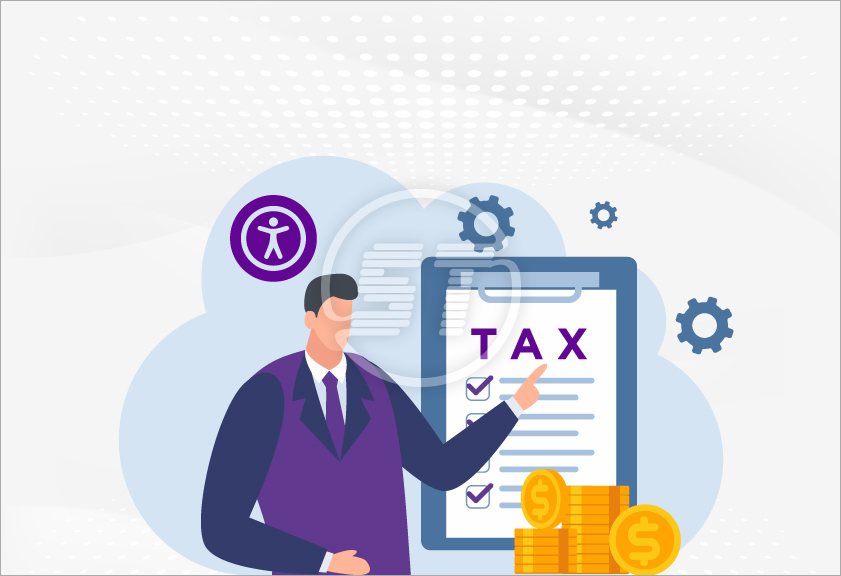Tax season is an inconvenience for both individuals and businesses. There are so many laws to adhere to simultaneously. However, the U.S. has made accessibility initiatives rewarding, especially for small businesses. If you own a small business and want to embrace accessibility, the ADA tax credit can help you recover costs. The goal of the tax benefit is to encourage owners or decision-makers to design and maintain an ADA-compliant website.
The accessibility initiatives can include various approaches, such as
- Native accessibility techniques,
- Automated tools,
- Assistive technologies, and
- Website audits.
Businesses can leverage various solutions and allow them to achieve the required ADA compliance and avoid legal consequences.
You might be aware of it or will realize it later on. The money invested in accessibility, whether it is online or offline, can add up to a big number at the end of the year. In this blog, you’ll get a complete understanding of
- What the ADA tax credit is,
- Who qualifies for it,
- How to claim it,
- Eligible expenses.
What is the ADA Tax Credit?
The ADA tax credit, also known as the Disabled Access Credit (DAC), is backed by Section 44 of the IRS Code, which covers 50% of the eligible accessibility expenses accrued during the previous tax year. The web accessibility expenses must amount to a minimum of $10,250. However, the first $250 accessibility expenses cannot be claimed. The maximum amount a business can claim for a year of expenses is $5000.
Here's how the math works:
Let's say you spent $8,000 on website accessibility improvements this year. Your calculation would be
- Total expenses: $8,000
- Subtract the first $250: $7,750
- Credit = 50% of $7,750 = $3,875 back to you
- Total accessibility expense from your pocket: $4,125
Pretty sweet deal, right?
Who Qualifies for Disabled Access Credit?
Most small-scale businesses qualify, but let's break it down clearly. Your business needs to meet just one of these criteria:
- Earning $1 million or less in the preceding tax year.
- You have no more than 30 full-time employees (working 30+ hours per week for 20+ weeks per year).
Franchise owners, heads up: You need to consider the total size across all locations and related entities, not just your franchise. The beauty of this credit is that you can claim it year after year, as long as you continue making eligible accessibility improvements.
What does count as eligible expenses?
Here’s where it gets interesting. Businesses can apply for the ADA tax credit and earn it on an annual basis. The accessibility expenditures cannot be carried forward from previous years to claim credit that has exceeded the expenditure limit.
However, if the credit amount you are entitled to exceeds the amount of taxes payable, you can carry the excess portion forward into the following year. The IRS is generous with what qualifies. Following is some of the qualified expenses for which you can receive a tax credit:
Digital Accessibility Upgrades
- Website redesign for WCAG compliance
- Screen reader compatibility improvements
- Mobile app accessibility features
- Online shopping cart accessibility
- Fees for consulting services
Communication Enhancements
- Assistive listening devices
- Braille or large-print marketing materials
- TTY services and interpreter costs
- Audio format documentation
How to apply for ADA Tax Credit?
Here’s the comprehensive application process to ensure that all the i’s are dotted and t’s are crossed. Firstly, you should refer to the Tax Incentives for Improving Accessibility Fact Sheet, which provides facts on the tax credit.
Once it is confirmed that your business is eligible, you must fill out Form 8826 to apply for the tax credit. Then it has to be attached to your annual tax return and submitted with it. You’ll find this form on the IRS website.
The ADA tax credit may be achieved by following three main steps:
- Keep detailed records of accessibility-related expenses (receipts, invoices, contracts, the whole nine yards)
- File IRS Form 8826 with your business tax returns
- Attach it to your return; that's it
The key is documentation. The IRS wants to see that your expenses were specifically for accessibility improvements, so detailed invoices that clearly describe the work are your best friend.
Maximize tax benefits like a Pro
Here’s where smart business owners get creative (legally, of course).
Expand the timeline for larger projects
If you’re planning a $20,000 accessibility overhaul, consider splitting it into two years. You’ll get $5,000 back each year instead of maxing out at $5,000 total.
Combine credits and deductions
Expenses over the $10,250 credit cap can still qualify for standard business deductions. So, if you spend $15,000 on accessibility, you’ll get $5,000 credit, plus you can deduct the remaining $5,000.
Plan strategically with your accountant
A competent tax professional can help effectively schedule your accessibility investments and help you reap maximum benefits in the form of tax credits.
Accessibility Beyond Taxes
Let’s talk about numbers that matter. According to the CDC, about 1 in 4 American adults has a disability. That’s roughly 61 million potential customers who might be struggling to access your business.
Making a business accessible helps to keep the business out of the courtroom but could also add revenue streams to the company. Additionally, accessible websites have better chances of ranking higher in search results, as pretty much all accessibility measures are also SEO best practices.
Reputation also matters. Upon finding acceptance in any business, people with disabilities will usually become very loyal customers. They will try to spread the word to friends, family, and online.
The 2025 Accessibility Landscape
What’s happening right now in the accessibility scenario makes this tax credit more valuable than ever. The Department of Justice (DOJ) announced that by 2024, all state and municipal government websites must comply with WCAG 2.1 AA standards, and private businesses are next in line for similar requirements.
What should be your action plan?
The ADA tax credit isn’t going anywhere, but the opportunity to use it effectively depends on taking action. Here’s your step-by-step game plan.
Step 1: Assess your current accessibility situation. If digital assets are not accessible, then it’s high time to start the accessibility journey and focus on making your digital assets accessible as soon as possible.
Step 2: Get quotes for necessary improvements. Remember, you want to stay within that sweet spot of $250-$10,250 per year for maximum credit benefit.
Step 3: Document everything. Keep receipts, contracts, and detailed descriptions of all accessibility work.
Step 4: File Form 8826 with your next tax return and watch that credit reduce your tax bill dollar for dollar.
How do we fit into your tax strategy?
When you’re ready to make accessibility improvements that qualify for the ADA tax credit, documentation is everything. The IRS wants to see clear evidence that your expenses were specifically for accessibility compliance.
That’s where professional accessibility services become invaluable. When you work with Skynet Technologies for your accessibility needs, you get detailed documentation of all compliance work. The kind of thorough records that make claiming your tax credit straightforward and audit-proof.
Our tax credit calculator can help you get a ballpark savings figure, and our comprehensive accessibility audits and remediation services, like
- Website Accessibility Audit,
- VPAT Report and Accessibility Conformance Report(ACR),
- ADA Web Accessibility Remediation,
To provide documented improvements, you need to maximize your credit.
Whether you’re
- updating your website for compliance,
- implementing assistive technologies, or
- creating accessible digital content,
We ensure every dollar you spend is properly documented for tax credit purposes. It’s not just about compliance; it’s about turning accessibility into a smart financial strategy.
You should also read: How much does it cost to remediate a website for ADA compliance?
Wrapping Up
The ADA tax credit transforms accessibility from a grudging compliance expense into a smart business investment. You’re protecting yourself from costly lawsuits, reaching new customers, and getting up to $5,000 back from Uncle Sam every year.
With nearly 4,000 accessibility lawsuits already recorded in 2024, and with the figure further projected to rise, the question isn’t whether you should be investing in accessibility or not. Instead, the question should be how smart it will be to claim the tax benefits deserved.
Don’t let another tax year go by leaving money on the table. Start planning your accessibility improvements today, keep those receipts, and turn compliance into cash back. Your business, your customers, and your tax bill will be thankful.
Ready for your calculations to generate tax savings?
Use our ADA tax credit calculator to evaluate your savings for the current year. For more detailed information about claiming the credit, check out our comprehensive guide on ADA tax credits or review the official IRS tax incentive documentation.
As an organizational member of W3C and IAAC, our team of experts specializes in providing a wide range of services to ensure your website is ADA compliant. We offer comprehensive ADA web accessibility remediation services including ADA website audit, design and development, remediation, retainer, monitoring, ongoing support, VPAT and ACR. Our services are tailored to meet the requirements such as ADA, WCAG 2.0, 2.1, and Section 508, all within your budget. If you would like to receive a free quote, please reach out to us at [email protected].


